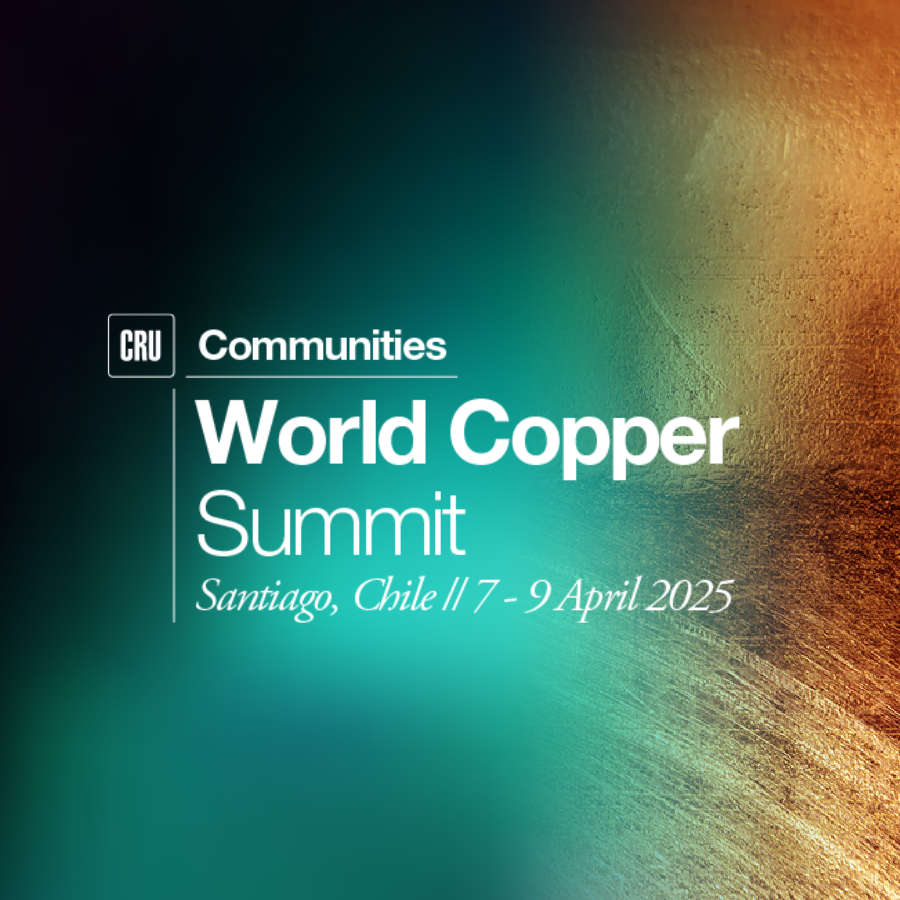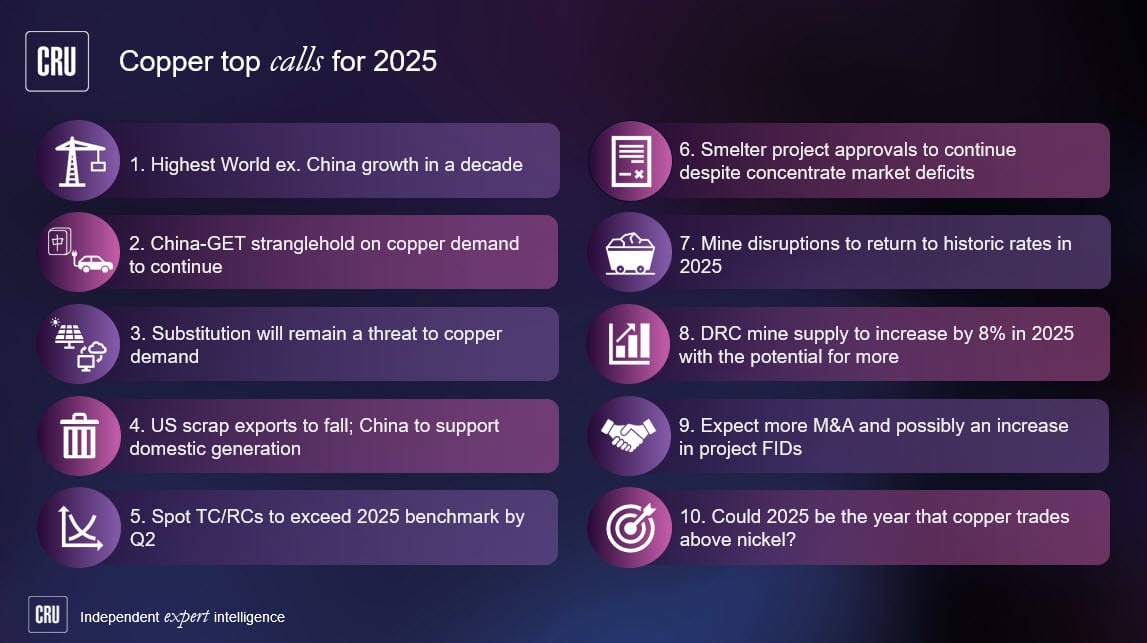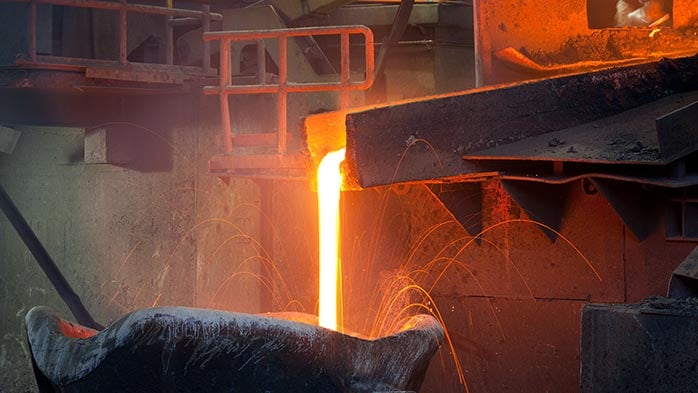Market intelligence is paramount for achieving optimal commercial outcomes in copper concentrate buying, selling and trading. This applies to understanding global and regional supply-demand dynamics, production costs for sellers, processing costs for buyers (to convert concentrate into finished products), and the understanding of the transaction value levers.
CRU empowers informed decision-making through our industry-leading copper cost analysis tools. The CRU Copper Minesite Cost Analysis Tool and CRU Copper Smelter and Refinery Cost Analysis Tool provide a granular breakdown of cost and revenue drivers in a typical copper concentrate transaction. Understanding this cost structure will allow you to negotiate with greater intelligence, ultimately securing more favourable commercial terms.
This insight leverages real-world data obtained from CRU's cost analysis tools. To ensure confidentiality, we have anonymised the names of the specific assets involved. For consistency, all calculations are presented in US dollars.
Significant Value Is Being Negotiated When Selling Copper Concentrates The figure below details the copper concentrate quality employed for this analysis. This is a clean concentrate that contains gold and silver. To calculate the value chain transaction, a production cost of $3,500 per tonne of copper (Cu) has been assigned.
Traditionally, sellers initiate a request for quotation (RFQ) process to engage the market. This involves inviting targeted buyers, such as smelters and traders, to submit bids. Ideally, sellers possess prior knowledge of potential buyers with the interest, capacity and capability to process their concentrate. CRU's database of smelters and refineries serves as a valuable tool in this regard, enabling sellers to make informed decisions when selecting participants for the RFQ process.
The seller receives purchase terms from each interested buyer. The analysis presented in this Insight uses a single offer term to simplify the calculation. The concentrate purchase terms for this concentrate are shown below. This set of terms was provided to CRU by a market participant for use in this Insight and represents actual offer terms in the market for a clean concentrate at the time such an offer was made. Actual market terms will change from time to time depending on market specificities:
Dynamics: Market conditions for copper concentrate significantly influence the offered terms, with the CRU Copper Concentrate Service providing insights into market dynamics.
Buyer Specifics: Different buyers may have unique terms based on their business needs.
Contract vs. Spot: Terms for long-term contracts may differ from those for spot purchases.
The commodity prices used to calculate the metal values within the concentrate. These prices are:
- Copper: $9,000 per tonne (t)
- Gold: $2,000 per troy ounce (oz t)
- Silver: $25 per troy ounce (oz t)
For reference, the contained metal value in the concentrate, based on these prices and the contained metal value determined using the offer terms, are presented below.
The calculation above yields a critical metric for evaluating competing offers – the percentage of net payable contained metal value. In this example, this metric indicates that 91.8% [(133.89 / 145.92) x 100] of the net payable amount to the concentrate seller reflects the value of the contained metal.
This metric plays a vital role in streamlining the buyer selection process following an RFQ. It facilitates the identification of a shortlist of potential buyers based on the offers received. Subsequent negotiations can then be pursued with these shortlisted buyers to secure the most favourable terms that maximise the seller's share of the overall value. Moreover, the settlement process for selling concentrate includes the weighing, sampling and moisture determination (WSMD) either at the discharge or loading port.
Commercial outcomes can be further optimised by understanding the smelter and refinery
In this example, CRU’s copper smelter and refinery database is used to randomly select a smelter and refinery that is suitable for processing this concentrate. The database hosts all smelter and refinery copper assets; and the accessible market for this concentrate (given its clean quality) is significantly larger.
In this example, an integrated smelter and refinery complex is selected. Furthermore, smelters and refineries generate additional revenues through the sale of products created from the concentrate, such as sulfuric acid. Additionally, some smelters generate excess electricity which is sold back to the grid. In this example, the smelter has significant sulphuric acid credits which is captured in the credit line. The selected smelters and refineries, together with key operating costs and parameters, are shown below.
Smelters and refineries have hidden revenue drivers
Smelters and refineries generate additional revenues from the copper concentrate that are not part of the payable terms. In order to completely tabulate the value of the concentrate to the buyer, a new term is introduced, the Accessible Value Pie.
This represents the complete value of the concentrate given the buyer’s various levers to extract revenue, and therefore forms what is fundamentally available for distribution to each party involved. The particulars of the smelter and refinery will determine how big the Accessible Value Pie can become. Furthermore, how much of this is available to the seller and buyer of the concentrate may be different due to factors influencing their respective negotiation positions. A detailed explanation of the Accessible Value Pie calculation is provided below.
Under the agreement, the concentrate buyer retains a portion of the payable metal. The seller incurs a separate processing charge for the material. Additionally, the buyer receives the full cathode premium, and any other credits associated with the concentrate such as sulfuric acid or minor metals. These combined elements represent the buyer's share of the 'Accessible Value Pie,' with the remaining portion going to the seller. A tabular representation of this breakdown is shown below.
The analysis can yield additional statistics about the transaction, particularly margins for each party. The margin is calculated as follows: (Total Revenue less Operating Cost) / Total Revenue. This is tabulated below.
The above calculation is the starting point of the negotiation. Further optimisation of the negotiated outcome is possible when bringing certain components of the buyer-only accessible value pie into the payable term sheet; and making this part of the accessible value pie for the seller. In the case discussed here, including a share of the copper cathode premium (as well as the margins generated on sulphuric acid sales) would result in an improvement in the margins. This sophisticated fine-tuning of the negotiation is possible through an understanding of the smelter and refinery processing and available value levers.
Smelters and refiners have levers to maximise the value of the concentrate which adds to their margins
Copper smelters process minor and deleterious elements present in the concentrate feed through various techniques and technologies. These elements, such as arsenic (As), antimony (Sb), bismuth (Bi), lead (Pb), and zinc (Zn), can be found in the concentrate feed due to the natural presence in the ore or because of the smelting process itself. The main methods used to remove these elements include:
- Feed preparation: Copper smelters use feed preparation techniques, such as blending and mixing, to ensure the feed materials are compatible with the smelting process. This helps to minimise the presence of minor elements in the feed and improve the overall efficiency of the process.
The mineralogical composition of the concentrate can affect the ease of separating the impurities. For example, arsenic is more easily removed from the copper circuit due to its high volatility, while antimony is not readily removed due to its lower partial pressure.
- Smelting processes: The primary smelting processes for copper, such as flash smelting and the ISASMELT process, are designed to remove impurities efficiently. These processes rely on high levels of volatilisation and strong bath agitation to promote the partitioning of impurities into the gas phase, which can then be removed through off-gas handling systems. The most efficient copper smelting processes for removing minor and deleterious elements are those that employ high oxygen partial pressures and calcium ferrite slags. These techniques are more effective than converting furnaces in removing arsenic (As) and antimony (Sb) from the copper concentrate feed.
- Slag chemistry and properties: The presence of minor elements in the slag can influence the slag chemistry and properties, such as surface tension and liquidus temperature. By understanding the behaviour of minor elements in copper smelting processes, it is possible to optimise the smelting process and maintain the desired final grade of the copper cathode.
- Electrolysis: In the final stage of copper production, electrolysis is used to produce copper cathodes from copper anodes. The presence of minor elements in the anodes can lead to the formation of floating slimes in the electrolysis tanks, which can cause short circuits and the inclusion of minor elements in the cathode. To avoid these problems, the copper industry has established accepted levels of minor elements in copper cathodes, such as 65 ppm for a Grade A cathode.
- Waste treatment: Copper smelters also employ waste treatment technologies, such as gas cleaning and slag treatment, to remove impurities from the off-gas and slag. These technologies help to reduce the environmental impact of the smelting process and improve the overall sustainability of copper production. Copper smelters can make money from removing minor and deleterious elements from the copper concentrate feed through several mechanisms:
- Penalties and credits:
Smelters can impose penalties on the miner/supplier if the concentrate contains high levels of certain impurities like arsenic, bismuth, lead, or tungsten. Penalties help offset the additional costs of removing these elements.
Conversely, smelters can provide credits to the miner/supplier if the concentrate contains valuable minor elements, like gold or silver, above a certain threshold. This allows the smelter to recover and sell these valuable by-products.
- Improved copper recovery and product quality:
By effectively removing minor and deleterious elements, smelters can improve the overall copper recovery rate and produce higher-quality copper products, such as copper cathodes, that command higher market prices.
- Recycling and reuse of waste streams:
Smelters can generate revenue by recycling and reusing the waste streams containing minor elements, such as off-gas solids and slag. These materials can be further processed to extract and recover valuable metals.
- Regulatory compliance and environmental benefits:
Effective removal of impurities helps smelters meet environmental regulations and reduce the environmental impact of their operations. This can lead to cost savings and potentially generate revenue through carbon credits or other green incentives.
- Technological advancements and process optimisation:
Investments in advanced technologies and process optimisation techniques to improve impurity removal can provide a competitive advantage for smelters, allowing them to have higher treatment or attract more concentrate supply.
CRU’s offers various must-have “tools of the trade” that enable better commercial outcomes. The cost analysis outlined in this Insight would be conducted in parallel for each potential partner during the bid negotiation stages. By understanding each party's cost structure, and the accessible value available to both sides while approaching the negotiation with a deep understanding of the transaction dynamics, both buyers and sellers can explore and test options to optimise their margins.
Additionally, CRU covers emissions for all the smelters and refineries in our cost database. Carbon footprint has become an important variable to consider as part of the negotiation process, given the increasingly strict carbon requirements towards Net Zero.
If you are interested to learn more about this, or explore more of it yourself, consider using the specialised “tools of the trade” CRU offers, without which this comprehensive analysis would not have been possible.

















